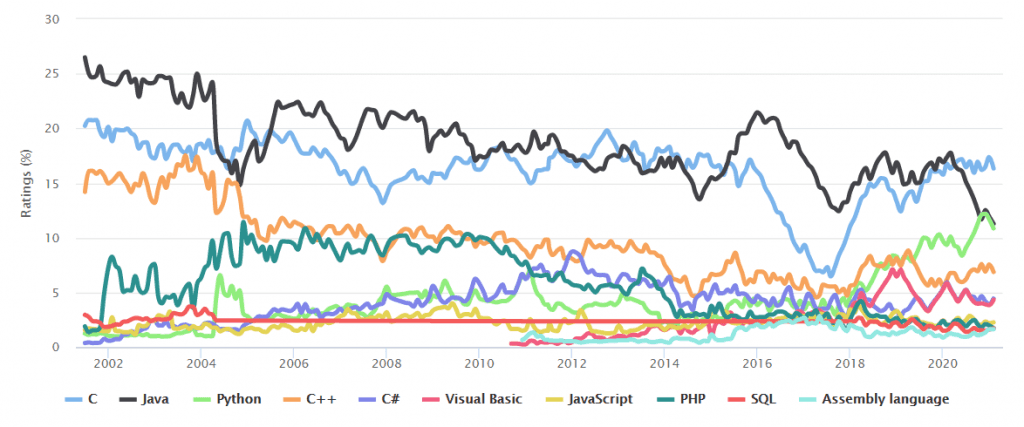9 of the best java testing frameworks for 2021
The fact is not alien to us anymore that cross browser testing is imperative to enhance your application’s user experience. Enhanced knowledge of popular and highly acclaimed testing frameworks goes a long way to develop a new app. It holds more significance if you are a full-stack developer or expert programmer. Most developers prefer Java because of its platform independence and ease of use to build anything – simple applications to sophisticated mobile apps, websites, and more.
In this article, we will share some of the most useful and best Java testing frameworks you can learn in 2021 to boost your career and improve your skill sets.
What are survey stats saying?
As per the TIOBE Popularity index for February 2021, Java is the second most popular programming language worldwide, with an overall rating of 11.29%.

In another survey conducted by Statista in 2020, Java was among the top five listings for broadly used programming languages worldwide, where almost 40.2% of respondents mentioned that they successfully used Java.

What are Java Testing Frameworks?
Java Frameworks can be referred to as the bodies of pre-defined code used by Java to create custom applications. The software testers or engineers can control the capabilities and use them to their advantage. Frameworks allow you to add your code to the enormous bodies of pre-written codes. The Java framework helps you focus on your business app’s core logic, avoiding the need to write code for basic functionalities like database connections, exception handling methods, and more.
Advantages Of Using Java Testing Frameworks
- Efficiency: Usually, web app development jobs take a substantial amount of time to finish, which can be easily resolved using Java frameworks, as its pre-written tasks make the jobs simpler.
- Security: Frameworks offers top-notch security to the applications and also helps mitigate security problems at a speedy pace.
- Support: Frameworks offer broad community support wherein you can mitigate all your issues and doubts within a short span.
- Expense: While we are talking about expenses, you would be relieved to know that the cost of maintenance for Java frameworks is relatively low. Development expenses are considerably reduced due to the usage of test automation frameworks.
Nine Best Java Testing Frameworks for 2021
There are myriads of Java testing frameworks presently accessible for QA testers. It is understandable that the more choices you have, the more intricate it is to decide the best one from the lot. Let us quickly go through 9 of the best Java testing frameworks:
1. JUnit

JUnit is one of the popular Java unit testing frameworks. The unit test is used in a path function or for testing a small piece of code. It plays a vital role in test-driven development and is a part of the collective unit test frameworks called xUnit. JUnit boosts the initiative of “to begin with testing than coding,” which highlights setting up the testing data for a part of code that should be tested prior to execution. This technique is akin to the “test a little, code a little” technique. It enhances the programmer’s productivity and program code’s stability, which in turn reduces the pressure on the programmer and minimizes the time spent on debugging.
JUnit 5.0 annotations added a lot of power and convenience to unit testing. Annotations ease the process of writing unit tests for examining exceptions. Expert developers who follow the test-driven approach should first write & run the unit testing before writing further code. Once the code is written, entire testing must be carried out and checked for appropriate results. Once a new test code is added, all test scenarios should be re-executed to ensure that everything is fine.
Core Features of JUnit
- JUnit offers test runners to execute tests.
- Enables you to write enhanced tests at an expedited pace.
- Offers annotations to simplify writing and maintaining of tests.
- Offers assertions to test anticipated outcomes.
- Less complicated and takes minimum time to execute.
- Test suites can contain test cases as well as other test suites.
Is JUnit an ideal Java testing framework for you?
While it is a primitive way for testing Java-based projects, it offers several advantages to teams:
- Early bug-finder : This framework can easily locate bugs at an early stage in comparison to other test automation frameworks. When an error is found, it is specified in a separate section until it is mitigated. This helps drive focus on debugging.
- Open Source : JUnit is a free and open-source testing framework. Hence, a passionate community is built around the framework.
- Better for TDD (Test-Driven Development): To catch bugs at an early stage, QA engineers prefer Test-Driven Development (TDD). Developers execute tests, and problems are resolved before taking the build for software tests. The framework uses assertions in testing, and the code throws an assert when encountered with a failure. The JUnit test framework is extremely useful with Test-Driven development.
2. JBehave

JBehave is also one of the best Java Testing Frameworks, primarily used with Selenium WebDriver for Java testing. JBehave framework is a BDD (Behaviour-Driven Development) framework, which was created in 2003. The ultimate objective behind JBehave is facilitating newcomers to understand and learn about Behaviour-Driven Development at a faster pace.
Core Features of JBehave
- Pure Java execution that plays well with Java-based enterprises or when interfacing to any environment that exposes a Java API.
- Stories can be executed at the same time, stating the number of concurrent threads.
- Shallow learning curve as user stories is written in Gherkin or JBehave syntax.
- Steps class specifications and annotation-based configuration.
- Groovy scripting for writing configuration and Steps instances.
- Dependency Injection supports enabling both configuration and stage instances composed through your favorite container (PicoContainer, Needle, Guice, Spring, Weld).
- Extensible story reports: outputs stories executed in varied human-readable file-based formats (TXT, HTML, XML). Fully style-able view.
- Ant integration- permits stories to be run through an Ant task.
- Maven integration: permits stories to be carried out via Maven plugin at specified build stage.
Is JBehave an ideal Java unit testing framework for you?
Beyond project managers, this framework rewards stakeholders, as it assists in improved transparency between test teams and the rest of the enterprise. Moreover, it also offers the following advantages to teams.
- Semi-formal language – This particular framework uses a semi-formal language, which is of immense help to the software developers. The presence of a domain vocabulary feature assists in managing consistency in the QA team structure.
- Great specifications – Products have better specifications as this form of testing framework for Java descriptively features intuitiveness and reasoning.
- Based on the concept of BDD development – JBehave is an ideal BDD automation framework in Java. Its capabilities can be leveraged to generate effective tests after seeking inputs from diverse stakeholders like engineers, product managers, etc.
3. Serenity

Serenity (earlier called Thucydides) is an open-source library perfectly designed for BDD (Behavior-Driven Development). It expands the WebDriver and JUnit attributes. This is also one of the widely preferred test automation frameworks that enable you to write well-structured tests. Serenity can also integrate with existing BDD frameworks such as JBehave.
Besides forming meaningful details for every single test, the tool also shows the traits tested in every test case. One of the best things about Serenity is that it supports a number of automated acceptance test solutions.
You can use this framework with JUnit to rapidly write maintainable tests or incorporate the same with Selenium WebDriver for testing web apps in Selenium. Serenity also supports RestAssured for testing REST API. The framework also allows you to use any BDD (Behaviour-driven Development) tool like Cucumber. You can use it with popular test management tools like JIRA.
Core Features of Serenity
- Helps in writing cleaner and maintainable automation & regression tests.
- Obtain Business-readable reports for every test.
- It can be used for automated web testing with Selenium.
- It can be integrated with other popular BDD tools like JBehave, Cucumber, as well as test automation frameworks like JUnit.
- Can be integrated with necessities stored in an external source (like JIRA or other test case management tools).
Is Serenity an ideal Java testing framework for you?
Serenity is known for its advanced integration features with popular BDD tools, test automation frameworks, and project management tools. Furthermore, it also provides the following advantages to teams:
- Informative Reports – The tool is mainly used to report acceptance criteria. However, the reports captured using Serenity are highly informative in comparison to other BDD frameworks like JBehave.
- Test Scenarios of higher quality – Serenity assists developers in writing automated test case scenarios of superior quality. It also offers support for Selenium WebDriver and RestAssured, thereby making it easy for the QA engineers to write automation-based acceptance tests.
4. Selenium

Selenium is an automated open-source (free) application testing framework that is used for cross browser testing. Selenium is a powerful framework to control and manage web browsers through the program. It is functional for almost every browser, works on most popular operating systems, and its scripts can be written in popular programming languages like C#, Java, Python, PHP, and more.
The Selenium Framework reduces the effort involved in the maintenance of the code.
Generally, three kinds of frameworks were created by Selenium for the automation of manual test cases: Keyword Driven Tests, Data-Driven Tests, and Hybrid Tests.
Core Features of Selenium
-
Selenium Integrated Development Environment gives a record and playback trait for authoring tests and for creating Selenium scripts for future reference.
-
Selenium supports several programming languages, OSs, and browsers:
- Operating Systems: iOS, Android, Windows, Mac, Solaris, Linux.
- Browsers: Internet Explorer, Google Chrome, Edge, Mozilla Firefox, Safari, Opera, etc.
- Programming Languages: Java, C#, PHP, Python, Ruby, JavaScript, etc.
-
Supports parallel test execution, which increases efficiency and reduces the test execution time.
-
It can be integrated with frameworks such as Ant, Maven, etc.
Is Selenium an ideal Java testing framework for you?
It is a robust framework to control web browsers through test automation code. Here’s what makes Selenium one of the most powerful testing frameworks:
- Reusability and Integrations – Cloud-based Selenium automation grid-like LambdaTest lets you run Selenium tests at scale. It helps in reducing the investment required for the creation of an in-house Selenium Grid infrastructure. Selenium can be seamlessly integrated with popular test automation frameworks like JUnit, TestNG, and more.
- Supported by Large Community – Selenium framework is open-source and has strong backing from the online community.
- Language and Framework Support – Supports major programming languages like C#, Java, Python, Ruby, JavaScript, PHP, etc.
5. TestNG

TestNG is a Java-based open-source testing framework. The framework is inspired by JUnit and NUnit. You can also create an HTML report during testing implementation.
It has features like grouping tests, annotations, parameterization, etc., that help in creating tests at a faster pace. These useful set of features makes TestNG a more robust framework in comparison to other test automation frameworks.
Core Features of TestNG
- Provides myriad kinds of after/ before annotations for support of distinct setup and cleanup choices.
- Allows users to perform data-driven testing
- Test suites in this framework are configured mainly utilizing XML files (i.e., testng.xml)
- Supports testing integrated classes.
- Provides flexible plugin API and flexible runtime configuration.
- Supports dependent test methods, load test, parallel tests, and partial failure.
- Support for multiple threaded testing.
Is TestNG an ideal Java testing framework for you?
This testing framework comes with systematic approaches and new functionalities to ease the task of testing. Here’s what makes it one of the best testing frameworks:
- Annotations, Grouping, and Parameterization – This specific trait is already present in the latest JUnit versions. These features are very helpful in complex projects where you may have to run a large number of test cases. In such scenarios, it’s better to get additional time and deploy this framework rather than depending entirely on other frameworks like JUnit.
- Robust Additional Functionality – TestNG covers functional testing, unit testing, integration, and E2E (End-to-End) testing. It has numerous class interfaces and techniques that ease the task of QA engineers.
6. Mockito

Mockito is an open-source and one of the preferred Java unit testing frameworks. This well-known Java-based mocking framework is primarily used for Java app unit testing. The major benefit of using Mockito is that there are no requirements to create mock objects, as the framework generates them automatically. It creates mocks by means of annotations.
Mockito is used for writing behavioral-based development tests with syntactic sugar (i.e., syntax lies in programming languages that assist in trouble-free reading.).
This internally uses the Java Reflection API for creating mock objects for a precise interface. The key goal of using the Mockito Java testing framework is to ease the test development by mocking exterior reliance and utilize it in the test implementation. Therefore, it gives a simplified test code that is understandable and easy to modify. We can also use Mockito with other frameworks like TestNG and JUnit.
Core Features of Mockito
- Mock objects reduce external reliance.
- Easily create mock objects using annotations like @Mock.
- It offers verification on the order of the method calls.
- Safe refactoring : As mock objects are formed at runtime, renaming a method or interface does not impact the test code.
Is Mockito an ideal Java testing framework for you?
Mocking is an essential technique of modern-day unit tests. This framework differentiates itself from different mocking or test frameworks by enabling developers to validate the SUT’s behavior (system under test) without setting up expectations. Here are the benefits it offers to the QA team:
- Create a proof of concepts or demos : Mocks are cost-effective and ideal for creating POC (proof of concept).
- Create tests in advanced TDD : This provides you the capability to add testing to your automated environment in the development procedure. In simple words, Service Mocking lets you exploit the capabilities offered by TDD (Test Driven Development)
- Best Void Method Handling : It handles void methods better than other mocking frameworks such as EasyMock.
- Class (not just Interface) Mocks: This framework enables you to mock classes and interfaces.
7. HTTPUnit
HTTPUnit is an open-source functional test framework based on JUnit.It imitates browser behavior like Page redirection, Form Submission, cookie management, and JS Validation, to name a few.
HttpUnit is also used to carry out testing of websites without the requirement for a web browser. The framework also supports automatic page redirection, HTTP basic access authentication, HTML form submission, JavaScript, and cookies.
This permits Java test code to process restored pages like XML Document Object Model (DOM), text, or containers of tables, forms, links, etc. This Java testing framework can be integrated with JUnit to write tests with ease.
It gives an API to interact with HTTP and HTML servers.
Core Features of HTTPUnit
- Used to test websites without any web browser.
- Support for cookies.
- Support for the HTTPS as well as HTTP protocols, along with support for HTML responses.
- It enables the test of web applications, and due to this, it also assists in regression tests.
- HTTPUnit is faster than other frameworks such as Selenium as you do not require a web browser for the tests.
- Better JavaScript support enables imitating the actions of the configured browser (Internet Explorer or Firefox).
- Proxy server support as well as great JavaScript support.
Is HTTPUnit an ideal Java testing framework for you?
HTTPUnit is a well-suited framework for the execution of automated acceptance tests or functional tests.
- Ease of use – HttpUnit imitates the relevant portions of browser behavior, including JavaScript, form submission, cookies, and automatic page redirection.
8. Gauge

Gauge is a Behavior Driven Java testing framework launched by ThoughtWorks.Inc. This is also one of the best Java Testing Frameworks, which allows software engineers to develop automated frameworks and speed up the software development procedure.
This open-source framework for Java takes the stress out of acceptance tests with minimum involvement of code. Like Selenium, this framework for Java can be used with popular languages such as C #, JavaScript, Java, Ruby, and Python.
Core Features of Gauge
- An extensive range of templates is accessible in the language of your choice.
- Command-Line support eases the integration with popular CI/CD tools.
- Easily create your plugin using the open-source Gauge API.
- Rapidly identify anomalies through screenshots of event failures.
- Enables you to generate scalable tests through parallel execution and provides integrations with cloud-based solutions such as LambdaTest to address the objectives of rapid cross browser testing.
Is Gauge an ideal Java testing framework for you?
This framework continues to make a noteworthy impact by providing numerous rewards for agile teams throughout the DevOps process. Here’s what makes it the ideal testing framework:
- Best framework for Cross-browser testing : This framework has revolutionized automated test procedures, allowing even non-technical personnel to write automated tests framework with ease.
- Parallel Test Execution : Gauge framework lets you parallelize the tests, thereby letting you run the tests at a fast pace.
9. Geb

Geb brings together the grace of jQuery content selection and the capabilities offered by WebDriver, Page Object Modelling (POM), and clarity offered by the Groovy language. Geb is open-source and licensed in the Apache License (Ver. 2.0).
Gauge can be used to effortlessly perform cross-browser testing using Selenium WebDriver. This framework can be used for normal automation, web scraping, and acceptance (and functional) testing in conjunction with other frameworks like Cucumber-JVM, TestNG, JUnit, and Spock.
Core Features of Geb
- It lets you execute the tests at a faster pace.
- Compatible with browsers such as Firefox, Chrome, IE, and HTMLUnit.
- Well-suited for running regression tests.
- While using Geb for automated tests, minimal test code modifications are needed if there are any UI changes in the app (or website). This minimizes the duplication of code.
Is Geb an ideal Java testing framework for you?
- Geb can be integrated with popular test automation frameworks like TestNG, Cucumber, Spock, and JUnit.
- It supports Page Object Model design pattern (by default).
Conclusion
Developing quality software is a challenging task for any developer. Mastering testing skills is the best way to ensure that you build a product that lasts. Java has evolved over the years, and Java testing frameworks have emerged to keep up with the need for high-quality application performance testing.
The perfect Java testing framework for your app (or website) can be used for performing automated browser tests with ease. Some of the most popular Java testing frameworks mentioned above are highly recommended for Selenium automation testing. LambdaTest, a cloud-based cross browser testing platform, supports all the major Java test automation frameworks and lets you perform testing at scale on 2000+ browsers, browser versions, and platforms.
Choose your framework cleverly to enjoy the features that Java offers and fulfill web applications and tools needed.
